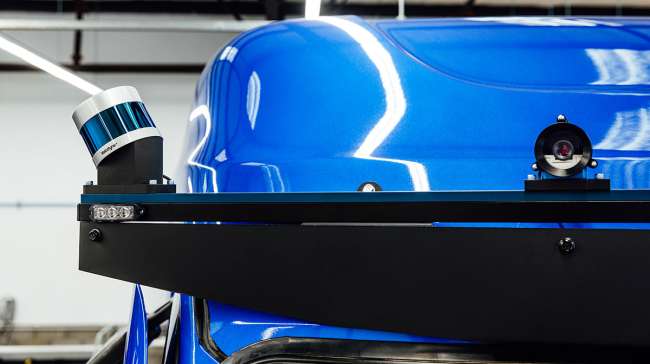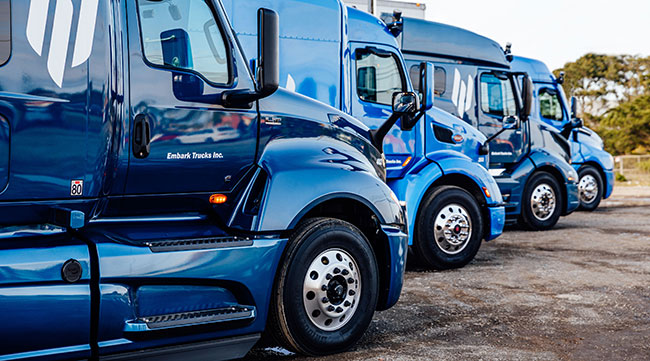Senior Reporter
Embark Announces First OEM-Agnostic Self-Driving Interface

[Stay on top of transportation news: Get TTNews in your inbox.]
Autonomous technology company Embark announced a new self-driving system whose components and flexible interfaces are intended to be OEM-agnostic and accelerate fleet deployments.
“[Embark is] now in the process of testing and refining the [Embark Universal Interface] system in preparation for our long-term goal of deep integration in collaboration with the OEMs,” Embark Chief Technology Officer Brandon Moak told Transport Topics, calling it the industry’s first such system.
Embark’s vision is for original equipment manufacturers to integrate Embark’s technology with their truck platforms, which they will then sell with the maintenance and warranty support carriers demand, according to the San Francisco-based company.

Moak
It pointed out fleets often operate trucks from more than one OEM and called that key to its go-to-market plan.
“Currently, we are leveraging input from multiple OEMs and Tier 1 suppliers to prepare the EUI to meet this demand,” Moak said. “Fortunately, the time and effort that Embark invests today will reduce the integration lead time for the OEMs, making it possible for them to more quickly fulfill carrier orders than might otherwise be possible with systems provided by other autonomous vehicle players.”
The Embark Universal Interface has been integrated with test trucks from Freightliner, International, Peterbilt, and Volvo, Moak said.
Freightliner is a brand of Daimler Trucks North America. International is a brand of Navistar Inc. Peterbilt Motors Co. is a Paccar Inc. brand, and Volvo Trucks North America is a brand of Volvo Group.
“We absolutely believe that integrating with OEMs is the path to market for self-driving trucks,”
Embark co-founder and CEO Alex Rodrigues said in a release. “We also believe that being cross-compatible and easy to integrate into all OEMs’ vehicles as their Level 4 platforms continue to develop gives us a competitive advantage.”

Rodrigues
During an interview in 2019, Rodrigues told TT his background is in competitive robotics as opposed “to big companies or academia.”
“[In competitive robotics,] you learn a great deal about building systems efficiently and on short time scales,” he said.
The EUI achieves its universality through a two-part design, the company reported.
Part 1 consists of a standardized components package — sensors and compute system — that have been determined through thousands of hours of design, testing, and analysis.
Part 2 is a set of physical, electrical and software interfaces that enable the standardized components package to connect to and communicate with any OEM platform’s steering, braking, throttle, telematics, power, chassis and HVAC.
At the center of the interface package is the Embark Gateway, an automotive-grade electronic control unit developed by Embark to enable application programming interface communication between Embark’s technology and any OEM platform.
Moak suggested Embark’s approach likely will translate to a less costly autonomous truck for fleets to buy and maintain.

Autonomous technology company Embark, which is based in San Francisco, was founded in 2016. (Embark)
“By Embark standardizing the core self-driving system design to work across all major OEM platforms, a portion of the design investment will be spread across a larger unit count,” he said. “Additionally, Embark will have fewer unique parts to manage, improving customer service through simplicity.”
One partner at a company that is an investor in Embark praised the move.
“We’ve seen time and time again how the emergence of an open platform can serve as a galvanizing force in fast-developing markets,” said Pat Grady, partner at Sequoia Capital, “and this breakthrough technology from Embark has a chance to do the same for what’s historically been a complex and fragmented industry.

Even before the pandemic, DHL's Larry S. Onge and Jim Monkmeyer set up strategies and implemented technology in order to respond to disruptions. Now, they know exactly how to get the vaccine from point A to point B — and, better, how to do it at a global scale. Hear a snippet, above, and get the full program by going to RoadSigns.TTNews.com.
“This is a huge step forward both for Embark and for the entire trucking industry.”
Other industries such as cybersecurity, software development and smartphone operating systems have been reshaped by interoperability, Embark noted.
Meanwhile, the pace of other self-driving companies securing additional capital and their own arrangements with truck makers is rising fast, as well.
Companies are pairing up, and like in other parts of the auto business, it is not unusual for manufacturers to work with multiple partners, said Sam Abuelsamid, principal analyst at Guidehouse Insights.
“Autonomous technology is not yet sufficiently mature for anybody to commit to a particular path. Everyone is hedging their bets with parallel paths,” Abuelsamid told TT, specifically referring to Volvo Group’s recent announcement it will partner with Aurora Innovation Inc. to develop and commercialize autonomous Class 8 trucks in North America.
Jerry Hirsch contributed to this article.
Want more news? Listen to today's daily briefing below or go here for more info:

